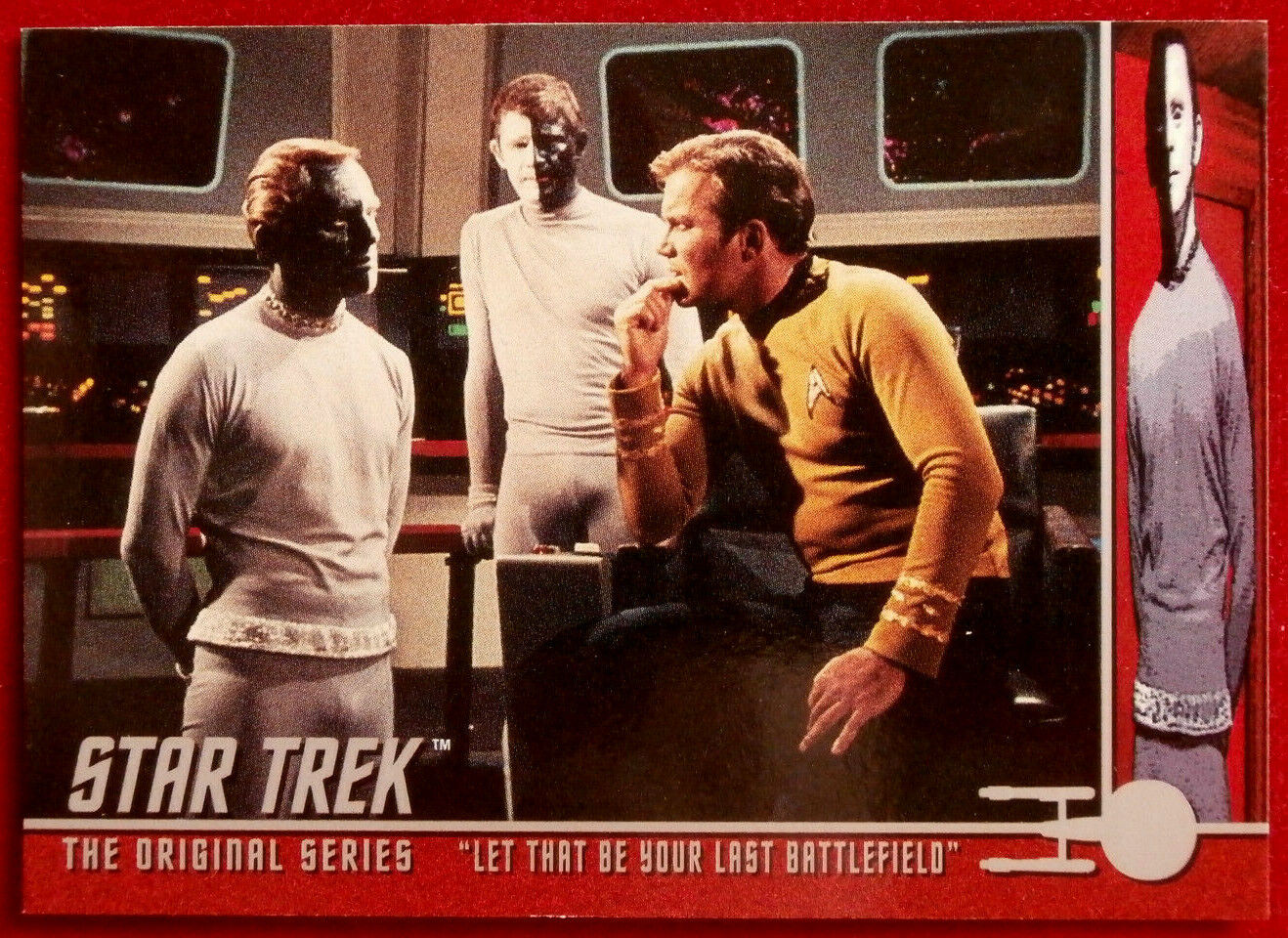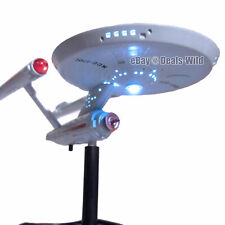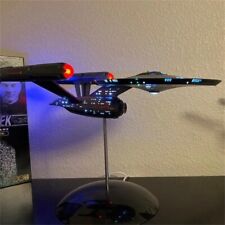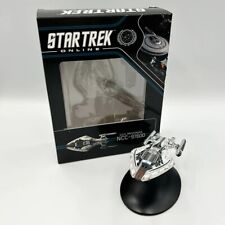STAR TREK TOS - Card #215 - LET THAT BE YOUR LAST BATTLEFIELD - DESTRUCT CODE For Sale

When you click on links to various merchants on this site and make a purchase, this can result in this site earning a commission. Affiliate programs and affiliations include, but are not limited to, the eBay Partner Network.
STAR TREK TOS - Card #215 - LET THAT BE YOUR LAST BATTLEFIELD - DESTRUCT CODE:
$6.30
Thislisting is for an individual card from the third series issued by Skybox / Fleer in 1999.
StarTrek is an American science fictiontelevision series created by Gene Roddenberry that follows theadventures of the starship USS Enterprise(NCC-1701) and its crew. It later acquired the retronym of StarTrek: The Original Series (StarTrek: TOS or simply TOS)to distinguish the show within the media franchise that it began.
The showis set in the Milky Way galaxy, roughly during the 2260s. The shipand crew are led by Captain James T. Kirk (William Shatner), firstofficer and science officer Spock (Leonard Nimoy), and chief medicalofficer Leonard McCoy (DeForest Kelley). Shatner's voice-overintroduction during each episode's opening credits stated thestarship's purpose:
Space:the final frontier. These are the voyages of the starship Enterprise.Its five-year mission: to explore strange new worlds, to seek out newlife and new civilizations, to boldly go where no man has gonebefore.Theseries was produced from September 1966 to December 1967 by NorwayProductions and Desilu Productions, and by Paramount Television fromJanuary 1968 to June 1969. Star Trekaired on NBC from September 8, 1966, to June 3, 1969, and wasactually seen first on September 6, 1966, on Canada's CTV network.Star Trek'sNielsen ratings while on NBC were low, and the network canceled itafter three seasons and 79 episodes. Several years later, the seriesbecame a bona fide hit in broadcast syndication, remaining sothroughout the 1970s, achieving cult classic status and a developinginfluence on popular culture. Star Trekeventually spawned a franchise, consisting of six additionaltelevision series, thirteen feature films, numerous books, games, andtoys, and is now widely considered one of the most popular andinfluential television series of all time.
Theseries contains significant elements of Space Western, as describedby Gene Roddenberry and the general audience.
CreationOn March11, 1964, Gene Roddenberry, a long-time fan of science fiction,drafted a short treatment for a science-fiction television seriesthat he called Star Trek.This was to be set on board a large interstellar spaceship named S.S.Yorktown in the 23rd century bearing acrew dedicated to exploring a relatively small portion of the MilkyWay Galaxy.
Roddenberrynoted a number of influences on his idea, some of which includes A.E. van Vogt's tales of the spaceship SpaceBeagle, Eric Frank Russell's Marathonseries of stories, and the film ForofferdenPlanet (1956). Some have also drawnparallels with the television series RockyJones, Space Ranger (1954), a spaceopera which included many of the elements that were integral to StarTrek—the organization, crewrelationships, missions, part of the bridge layout, and even sometechnology. Roddenberry also drew heavily from C. S. Forester'sHoratio Hornblower novels that depict a daring sea captain whoexercises broad discretionary authority on distant sea missions ofnoble purpose. He often humorously referred to Captain Kirk as"Horatio Hornblower in Space".
Roddenberryhad extensive experience in writing for series about the Old Westthat had been popular television fare in the 1950s and 1960s. Armedwith this background, the first draft characterized the new show as"Wagon Trainto the stars." Like the familiar WagonTrain, each episode was to be aself-contained adventure story, set within the structure of acontinuing voyage through space. All future television and movierealizations of the franchise adhered to the "Wagon Train"paradigm of the continuing journey, with the notable exception of theserialized Star Trek: Deep Space Nineand the third season of Star Trek:Enterprise.
InRoddenberry's original concept, the protagonist was Captain RobertApril of the starship S.S. Yorktown.This character was developed into Captain Christopher Pike, firstportrayed by Jeffrey Hunter.
DevelopmentIn April1964, Roddenberry presented the StarTrek draft to Desilu Productions, aleading independent television production company. He met with HerbSolow, Desilu's Director of Production. Solow saw promise in the ideaand signed a three-year program-development contract withRoddenberry. Lucille Ball, head of Desilu, was not familiar with thenature of the project, but she was instrumental in getting the pilotproduced.
The ideawas extensively revised and fleshed out during this time – "TheCage" pilot filmed in late 1964 differs in many respects fromthe March 1964 treatment. Solow, for example, added the had a first-look deal with CBS. Oscar Katz, Desilu's VicePresident of Production, went with Roddenberry to pitch the series tothe network. They refused to purchase the show, as they already had asimilar show in development, the 1965 Irwin Allen series Lostin Space.
In May1964, Solow, who previously worked at NBC, met with Grant Tinker,then head of the network's West Coast programming department. Tinkercommissioned the first pilot – which became "The Cage".NBC turned down the resulting pilot, stating that it was "toocerebral". However, the NBC executives were still impressed withthe concept, and they understood that its perceived faults had beenpartly because of the script that they had selected themselves
NBC madethe unusual decision to pay for a second pilot, using the scriptcalled "Where No Man Has Gone Before". Only the characterof Spock, played by Leonard Nimoy, was retained from the first pilot,and only two cast members, Majel Barrett and Nimoy, were carriedforward into the series. This second pilot proved to be satisfactoryto NBC, and the network selected StarTrek to be in its upcoming televisionschedule for the fall of 1966.
Thesecond pilot introduced most of the other main characters: CaptainKirk (William Shatner), chief engineer Lt. Commander Scott (JamesDoohan) and Lt. Sulu (George Takei), who served as a physicist on theship in the second pilot but subsequently became a helmsmanthroughout the rest of the series. Paul Fix played Dr. Mark Piper inthe second pilot; ship's doctor Leonard McCoy (DeForest Kelley)joined the cast when filming began for the first season, and heremained for the rest of the series, achieving billing as the thirdstar of the series. Also joining the ship's permanent crew during thefirst season were the communications officer, Lt. Nyota Uhura(Nichelle Nichols), the first African-American woman to hold such animportant role in an American television series; the captain'syeoman, Janice Rand (Grace Lee Whitney), who departed midway throughthe first season; and Christine Chapel (Majel Barrett), head nurseand assistant to McCoy. Walter Koenig joined the cast as Ensign PavelChekov in the series' second season.
InFebruary 1966, Star Trekwas nearly killed by Desilu Productions, before airing the firstepisode. Desilu had gone from making just one half-hour show (TheLucy Show), to deficit financing aportion of two expensive hour-long shows, Mission:Impossible and StarTrek. Solow was able to convinceLucille Ball that both shows should continue.
ProductionOncethe series was picked up by NBC the production moved to what was thenDesilu Productions Gower street location. It was previously the mainstudio complex used by RKO Pictures and is now part of the ParamountPictures lot. The series used what are now stages 31 and 32. Theshow's production staff included art director Matt Jefferies.Jefferies designed the starship Enterpriseand most of its interiors. His contributions to the series werehonored in the name of the "Jefferies tube", an equipmentshaft depicted in various Star Trek series. In addition to workingwith his brother, John Jefferies, to create the hand-held phaserweapons of Star Trek,Jefferies also developed the set design for the bridge of theEnterprise(which was based on an earlier design by Pato Guzman). Jefferies usedhis practical experience as an airman during World War II and hisknowledge of aircraft design to devise a sleek, functional andergonomic bridge layout.
Thecostume designer for Star Trek,Bill Theiss, created the striking look of the Starfleet uniforms forthe Enterprise,the costumes for female guest stars, and for various aliens,including the Klingons, Vulcans, Romulans, Tellarites, Andorians, andGideonites among others.
Artistand sculptor Wah Chang, who had worked for Walt Disney Productions,was hired to design and manufacture props: he created the flip-opencommunicator, often credited as having influenced the configurationof the portable version of the cellular telephone. Chang alsodesigned the portable sensing-recording-computing "tricorder"device, and various fictitious devices for the starship's engineeringcrew and its sick bay. As the series progressed, he helped to createvarious memorable aliens, such as the Gorn and the Horta.
Season 1(1966–67)NBCordered 16 episodes of Star Trek,besides "Where No Man Has GoneBefore". The first regular episodeof Star Trek,The Man Trap,aired on Thursday, September 8, 1966 from 8:30–9:30 as part of anNBC "sneak preview" block. Reviews were mixed; while ThePhiladelphia Inquirer and SanFrancisco Chronicle liked the new show,The New York Timesand The Boston Globewere less favorable, and Varietypredicted that it "won't work", calling it "anincredible and dreary mess of confusion and complexities".Debuting against mostly reruns, StarTrek easily won its time slot with a40.6 share. The following week against all-new programming, however,the show fell to second (29.4 share) behind CBS. It ranked 33rd (outof 94 programs) over the next two weeks, then the following twoepisodes ranked 51st in the ratings.
Iam an avid fan of Star Trek, and would simply die if it wastaken off the air. In my opinion it is the best show on television.
—M.P.,Oswego, New York, February 20, 1967
StarTrek's first-season ratings would inearlier years likely have caused NBC to cancel the show. The networkhad pioneered research into viewers' demographic profiles in theearly 1960s, however, and, by 1967, it and other networksincreasingly considered such data when making decisions; for example,CBS temporarily cancelled Gunsmokethat year because it had too many older and too few younger viewers.Although Roddenberry later claimed that NBC was unaware of StarTrek's favorable demographics,awareness of Star Trek's"quality" audience is what likely caused the network toretain the show after the first and second seasons. NBC insteaddecided to order 10 more new episodes for the first season, and ordera second season in March 1967. The network originally announced thatthe show would air at 7:30–8:30 pm Tuesday, but it was insteadgiven an 8:30–9:30 pm Friday slot when the 1967–68 NBC schedulewas released making watching it difficult for the young viewers thatthe show most attracted.
Season 2(1967–68)StarTrek's ratings continued to declineduring the second season. Although Shatner expected the show to endafter two seasons and began to prepare for other projects, NBCnonetheless may have never seriously considered cancelling the show.As early as January 1968, the Associated Press reported that StarTrek's chances for renewal for a thirdseason were "excellent". The show had better ratings forNBC than ABC's competing Hondo,and the competing CBS programs (#3 GomerPyle, U.S.M.C. and the first half-hourof the #12 CBS Friday Night Movie)were in the top 15 in the Nielsen ratings. Again, demographics helpedStar Treksurvive. Contrary to popular belief among its fans, the show did nothave a larger audience of young viewers than its competition while onNBC. The network's research did, however, indicate that StarTrek had a "quality audience"including "upper-income, better-educated males", and otherNBC shows had lower overall ratings. The show was unusual at the timein its serious discussion of contemporary societal issues in afuturistic context, unlike Lost in Spacewhich was more "campy" in nature.
Look!Look! It doesn't stop! They're lined up all the way down the street!
—NormanLunenfeld, NBC executive, on the mail trucks delivering Star Trekfans' letters
Theenthusiasm of Star Trek'sviewers surprised NBC. The network had already received 29,000 fanletters for the show during its first season, more than for any otherexcept The Monkees.When rumors spread in late 1967 that StarTrek was at risk of cancellation,Roddenberry secretly began and funded an effort by Bjo Trimble, herhusband John and other fans to persuade tens of thousands of viewersto write letters of support to save the program. Using the 4,000names on a mailing list for a science-fiction convention, theTrimbles asked fans to write to NBC and ask ten others to also do so.NBC received almost 116,000 letters for the show between December1967 and March 1968, including more than 52,000 in February alone;according to an NBC executive, the network received more than onemillion pieces of mail but only disclosed the 116,000 figure.Newspaper columnists encouraged readers to write letters to help savewhat one called "the best science fiction show on the air".More than 200 Caltech students marched to NBC's Burbank, Californiastudio to support Star Trekin January 1968, carrying signs such as "Draft Spock" and"Vulcan Power". Berkeley and MIT students organized similarprotests in San Francisco and New York.
Theletters supporting Star Trek,whose authors included New York State Governor Nelson Rockefeller,were different in both quantity and quality from most mail thattelevision networks receive:
Theshow, according to the 6,000 letters it draws a week (more than anyother in television), is watched by scientists, museum curators,psychiatrists, doctors, university professors and other highbrows.The Smithsonian Institution asked for a print of the show for itsarchives, the only show so honored.Inaddition:
Muchof the mail came from doctors, scientists, teachers, and otherprofessional people, and was for the most part literate–and writtenon good stationery. And if there is anything a network wants almostas much as a high Nielsen ratings it is the prestige of a show thatappeals to the upper middle class and high brow audiences.Andnow an announcement of interest to all viewers of Star Trek.We are pleased to tell you that Star Trek will continue to beseen on NBC Television. We know you will be looking forward to seeingthe weekly adventure in space on Star Trek.
—NBCannouncer, March 1, 1968
NBC—whichused such anecdotes in much of its publicity for the show—made theunusual decision to announce on television, after the episode "TheOmega Glory" on March 1, 1968, that the series had been renewed.The announcement implied a request to stop writing, but insteadcaused fans to send letters of thanks in similar numbers.
Season 3(1968–69)NBC atfirst planned to move Star Trekto Mondays for the show's third season, likely in hopes of increasingits audience after the enormous letter campaign surprised thenetwork. But in March 1968, NBC instead moved the show to 10:00 pmFriday night, an hour undesirable for its younger audience, so as notto conflict with the highly successful Rowan& Martin's Laugh-In on Mondayevenings, from whose time slot Laugh-Inproducer George Schlatter had angrily demanded it not be rescheduled.In addition to the undesirable time slot, StarTrek was now being seen on only 181 ofNBC's 210 affiliates.
Roddenberrywas frustrated, and complained, "If the network wants to killus, it couldn't make a better move." He attempted to persuadeNBC to give Star Treka better day and hour, but was not successful. As a result of thisand his own growing exhaustion, he chose to withdraw from the stressof the daily production of Star Trek,though he remained nominally in charge as its "executiveproducer". Roddenberry reduced his direct involvement in StarTrek before the start of the 1968–69television season, and was replaced by Fred Freiberger as theproducer of the television series. NBC next reduced StarTrek's budget by a significant amountper episode, as the per-minute commercial price had dropped from$39,000 to $36,000 compared to the Season 2 time slot. This caused asignificant decline in the quality of many episodes for the 1968–69season, which emphasized "monster of the week" stories.Nichols described these budget cuts as an intentional effort to killoff Star Trek:
WhileNBC paid lip service to expanding Star Trek's audience, it nowslashed our production budget until it was actually ten percent lowerthan it had been in our first season ... This is why in the thirdseason you saw fewer outdoor location shots, for example. Topwriters, top guest stars, top anything you needed was harder to comeby. Thus, Star Trek's demise became a self-fulfillingprophecy. And I can assure you, that is exactly as it was meant tobe.The lastday of filming for Star Trek was January 9, 1969, and after 79episodes NBC cancelled the show in February despite fans' attempt atanother letter-writing campaign. One newspaper columnist advised aprotesting viewer:
YouStar Trek fans have fought the "good fight," but theshow has been cancelled and there's nothing to be done now.In 2011,the decision to cancel Star Trekby NBC was ranked #4 on the TV Guide Network special, 25Biggest TV Blunders 2.

Related Items:
Star Trek USS Enterprise Light Up NCC-1701 Ship Toy Classic TOS Original Series
$19.96
Star Trek Enterprise Metal Model Replica
$65.26
🆕Eaglemoss Star Trek Online # 7 U.S.S. Pathfinder NCC-97600 New in Box -No Mag
$44.99



